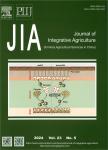Overexpression of the Suaeda salsa SsNHX1 gene confers enhanced salt and drought tolerance to transgenic Zea mays
Overexpression of the Suaeda salsa SsNHX1 gene confers enhanced salt and drought tolerance to transgenic Zea mays作者机构:Key Laboratory of Biology and Genetic Improvement of Maize in Southwest Region Ministry of Agriculture/Maize Research Institute Sichuan Agricultural University
出 版 物:《Journal of Integrative Agriculture》 (农业科学学报(英文版))
年 卷 期:2018年第17卷第12期
页 面:2612-2623页
核心收录:
学科分类:09[农学]
基 金:supported by the National Natural Science Foundation of China(31561143014,30800687,31071434,and 31522041) the Major Project of Education Department of Sichuan Province,China(15ZA0022)
主 题:Na^+/H^+ antiporter salt stress K^+/Na^+ drought stress gene transformation
摘 要:Maize is one of the most important crops worldwide, but it suffers from salt stress when grown in saline-alkaline soil. There is therefore an urgent need to improve maize salt tolerance and crop yield. In this study, the SsNHX1 gene of Suaeda salsa, which encodes a vacuolar membrane Na~+/H~+ antiporter, was transformed into the maize inbred line 18-599 by Agrobacterium-mediated transformation. Transgenic maize plants overexpressing the SsNHX1 gene showed less growth retardation when treated with an increasing NaCl gradient of up to 1%, indicating enhanced salt tolerance. The improved salt tolerance of transgenic plants was also demonstrated by a significantly elevated seed germination rate(79%) and a reduction in seminal root length inhibition. Moreover, transgenic plants under salt stress exhibited less physiological damage. SsNHX1-overexpressing transgenic maize accumulated more Na~+ and K~+ than wild-type(WT) plants particularly in the leaves, resulting in a higher ratio of K~+/Na~+ in the leaves under salt stress. This result revealed that the improved salt tolerance of SsNHX1-overexpressing transgenic maize plants was likely attributed to SsNHX1-mediated localization of Na~+ to vacuoles and subsequent maintenance of the cytosolic ionic balance. In addition, SsNHX1 overexpression also improved the drought tolerance of the transgenic maize plants, as rehydrated transgenic plants were restored to normal growth while WT plants did not grow normally after dehydration treatment. Therefore, based on our engineering approach, SsNHX1 represents a promising candidate gene for improving the salt and drought tolerance of maize and other crops.



